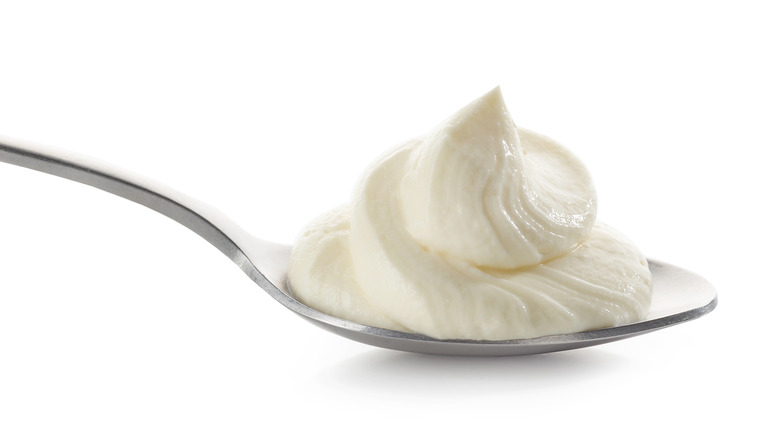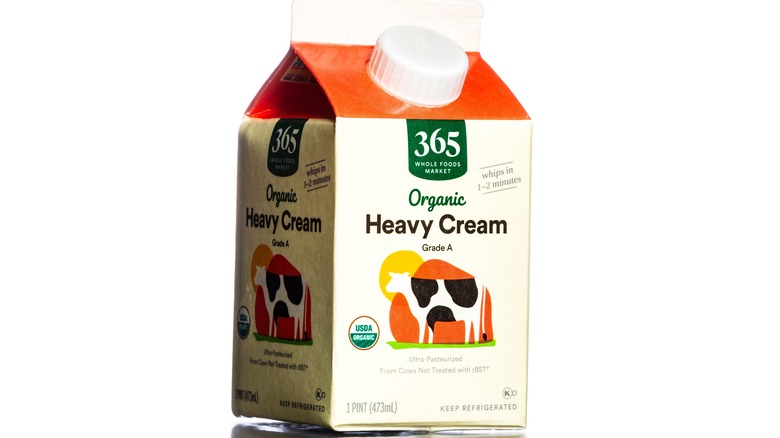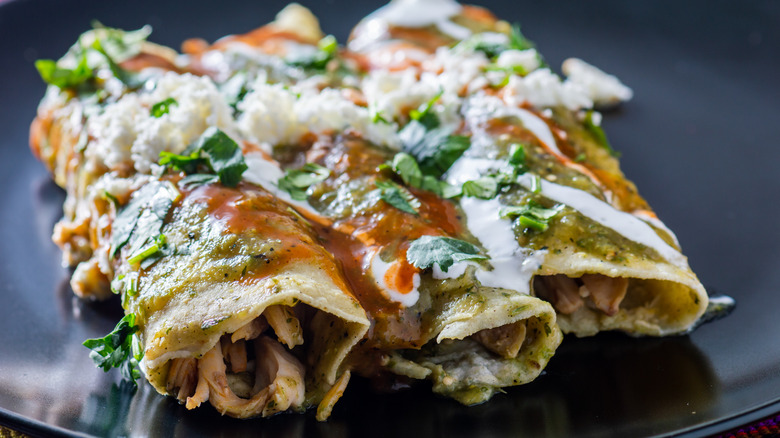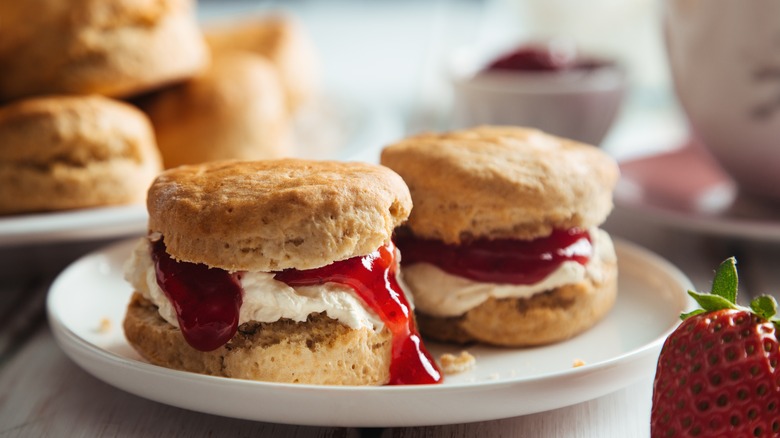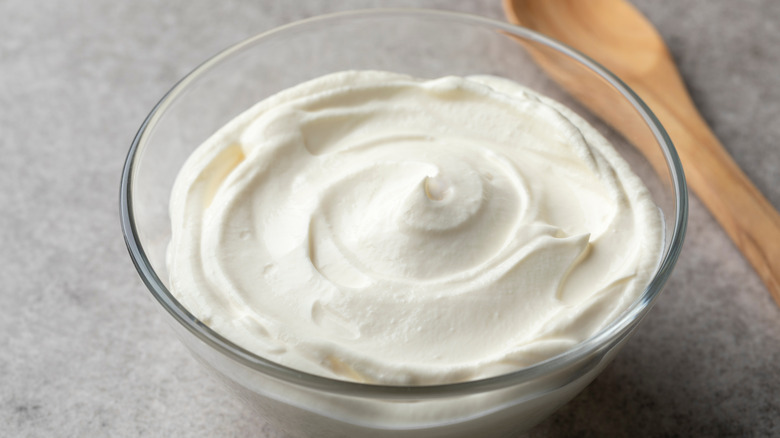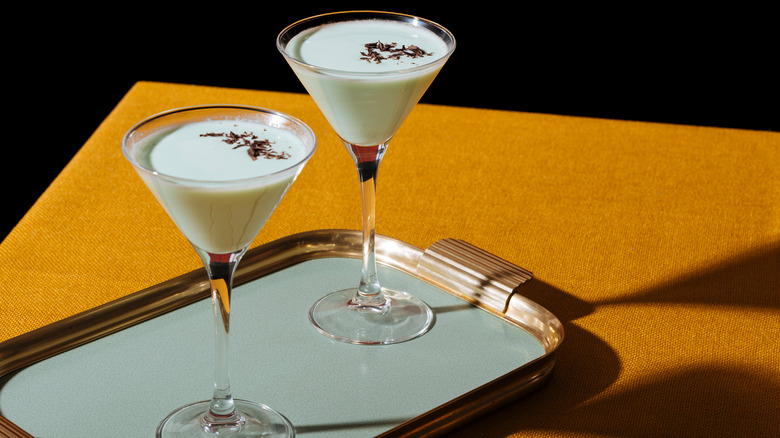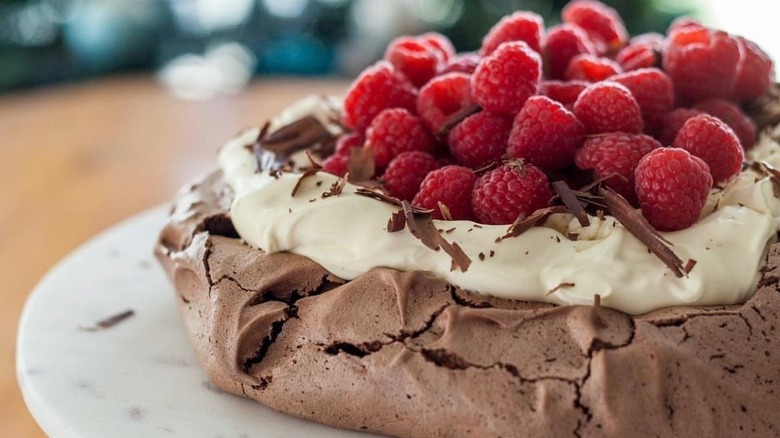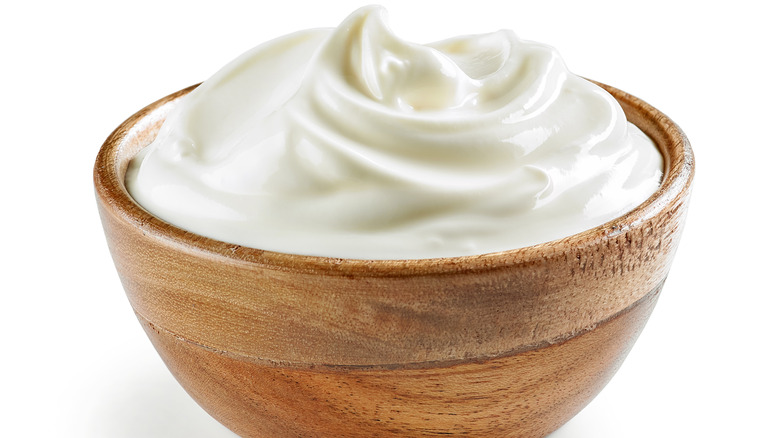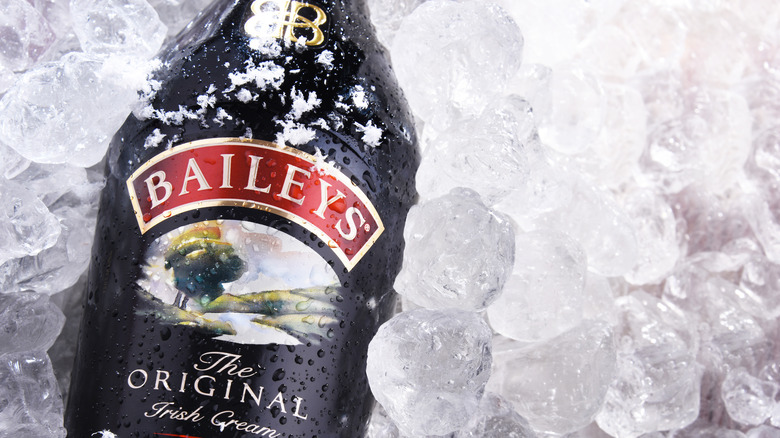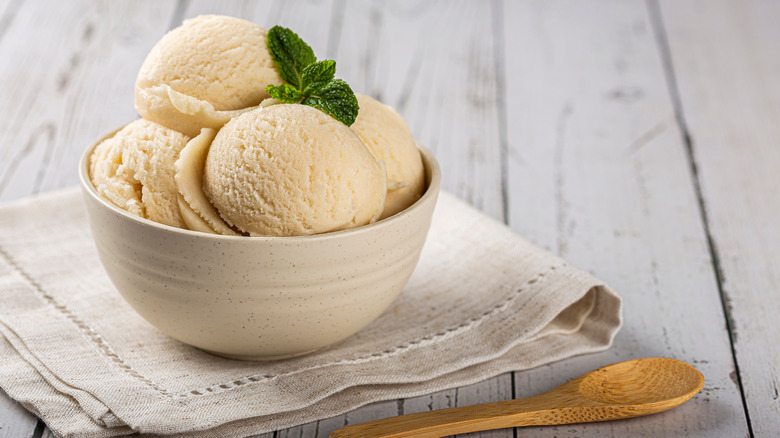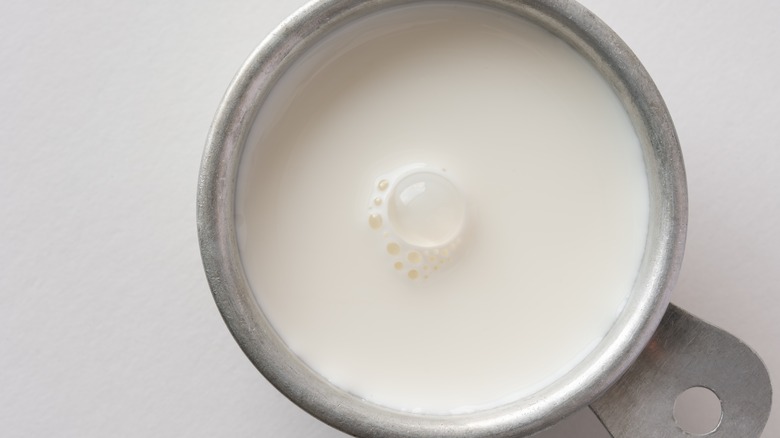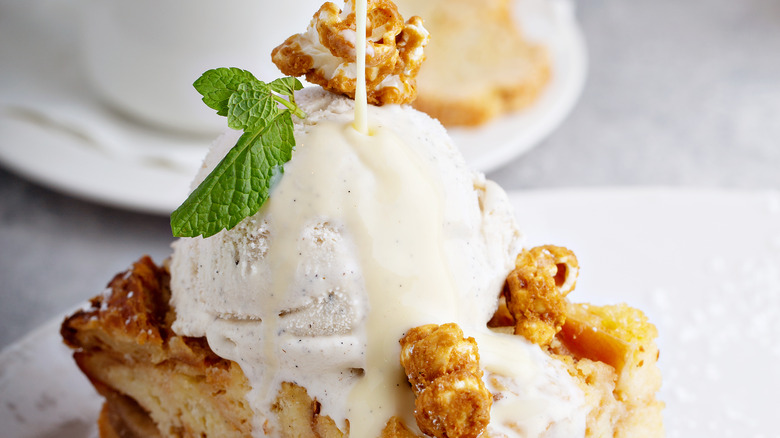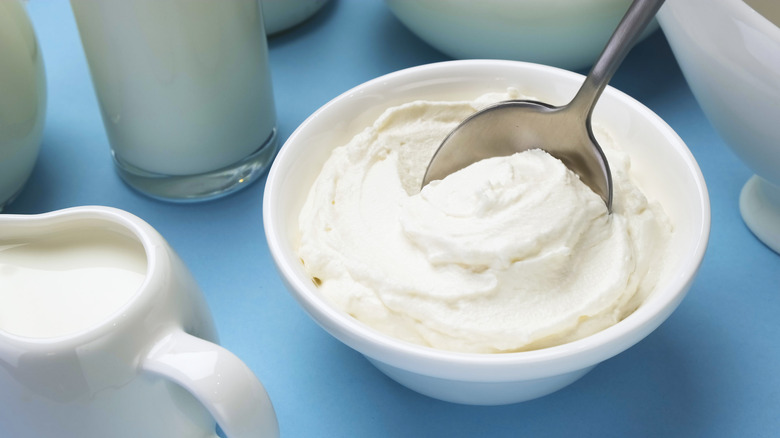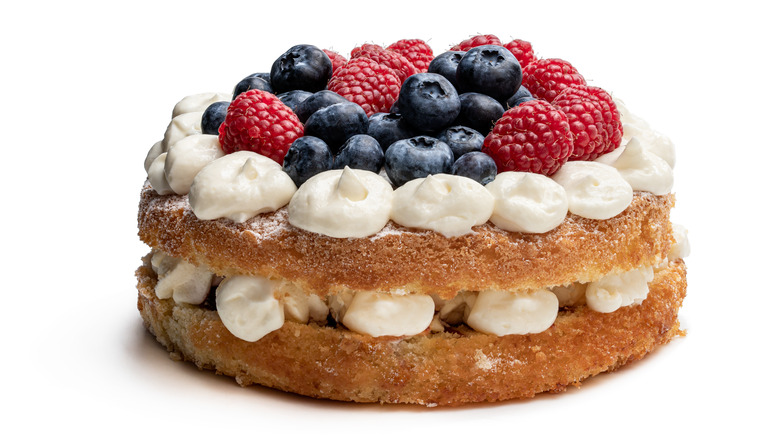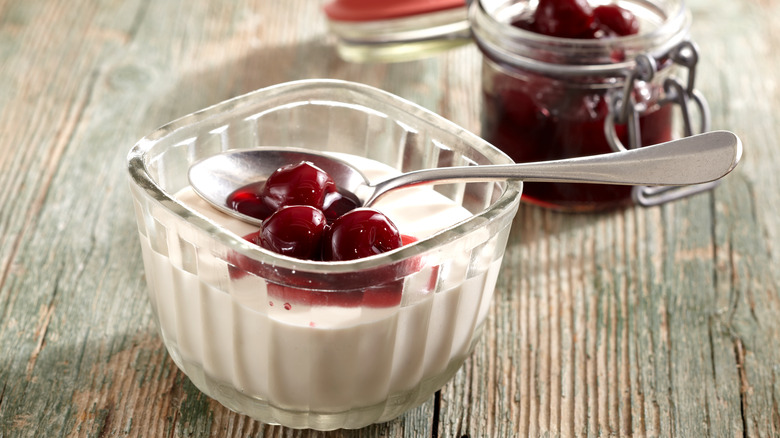14 Types Of Cream, Explained
Cream, in its many forms and varieties, is a common kitchen ingredient for a variety of cuisines. By definition, a "cream" is an animal-based dairy product taken from the fatty portion of milk before homogenization — the process that whips all the components of the milk together for a better appearance and flavor (via RecipeTips). All creams have a higher butterfat than regular milk and are much thicker. We should also note that the process in cooking called "creaming" is unrelated to cream itself; creaming refers to the process of whipping butter and sugar together at high speeds to make cakes, cookies, and similar sweetened baking products.
RecipeTips notes that the United States has three main forms of cream: heavy cream, light cream, and half-and-half. Other countries have up to 10 different classifications for types of cream. The main determining factor in what separates the cream types is the respective milk-fat concentration. Creams with a higher milk-fat, per the Epicentre, are richer and tend to curdle less in hot liquids. Although it is argued that some types of cream taste better than others, we believe that every type of cream can be the highlight of a dish — so long as it is prepared and used correctly.
Heavy cream
Heavy cream is one of the fattier types of cream on the market. It has a marginally-higher butterfat percentage than whipping cream, at no less than 36%, so it is better at holding its shape after it is whipped. Heavy cream is most popular for piping, topping, and filling sweet baked goods because of its unctuous mouth-feel and physical qualities.
The high-fat content of heavy cream does have some downsides. Because of how fatty it is, heavy cream tends to lump more than whipping cream. We recommend using heavy cream to make a soft, buttery baked egg recipe or combine with milk for a smooth ice cream recipe. If you don't have ready access to heavy cream, you can use some substitutes like combining butter and milk, half-and-half and butter, or for a dairy-free version, try coconut cream. It is important to think of using high fat when looking for a heavy cream substitutes so you can accomplish similar results.
Crema
Crema is an ingredient common in Mexican dishes. Crema's flavor is a cross between traditional sour cream and crème fraîche. Crema is rarely used as an ingredient in dishes and is instead reserved as a condiment for topping spicy dishes like enchiladas or pozole. The creaminess of the crema and its slight tang gives relief from the heat and spice common in Mexican cuisines, but it can also be used as a dip when combined with puréed adobo peppers, hot sauce, and avocado.
If you don't have access to crema for your family taco night, your next best thing might be sour cream. Sour cream is less thick than crema but will replicate the same tang and reprieve from the heat. If you want a creamier texture, opt for mixing crème fraîche with lime juice or water (for less tang). The thickness of the crème fraîche is more comparable to crema.
Clotted cream
Clotted cream is a common adornment for scones and jam in England. This type of cream has the highest butterfat of all of the cream types at around 55-65%, per Masterclass. The rich texture resembles that of the whipped butter you pair with pancakes at an American diner.
You can make clotted cream at home with only one ingredient: heavy cream. When heavy cream is baked at 180 F in a wide baking dish, the water in the heavy cream evaporates and further concentrates the fat. This process may seem arduous because it takes about 12 hours for the fat to concentrate and another 12 hours to cool in your fridge before it is ready to be spooned on top of you favorite scones. You can also add clotted cream to fudge or shortbread for an added layer of decadence. Store your homemade clotted cream in your fridge for up to a week — if this decadent cream lasts that long.
Crème fraîche
Crème fraîche is a French cream that differs from other high-fat creams because of the addition of a bacteria culture. The flavor is somewhat nutty while the texture is super thick and creamy. It is sweeter than sour cream, so it has a lot of utility in baking and topping sweet dishes. While you can make your own crème fraîche with buttermilk and heavy cream, this dairy product is common enough in most grocery stores for you to pick up a container with ease.
Use your crème fraîche to top a fresh cobbler or fruit pie. The distinct tang of the cream will provide a newfound complexity and flavor compared to the sheer sweetness of the fruit. For a savory dish, we recommend adding a scoop of crème fraîche to your next batch of mashed potatoes. The creaminess and tang of the crème fraîche can replace butter or milk and is perfect when paired with a fresh green onion garnish.
Light cream
Light cream has the lowest butterfat out of the cream designation scale in the United States. According to Delighted Cooking, light cream has a butterfat concentration between 18% and 30% and can be otherwise known as "coffee cream" or "table cream." Although the name implies that this cream is "light," it is still thicker than half-and-half and plain milk. The relatively low-fat concentration of light cream does not result in an effective whip. If you're looking for a whipped topping for your fruit cobbler or scones, stick to whipping cream, heavy cream, or clotted cream. You'll also want to avoid using light cream in high-heat sauces or soups because it can split easily.
Light cream is most often used for a boost in coffee or alcoholic beverages. You can easily flavor light cream by mixing it with vanilla or almond extract, or make it thicker by stirring in cornstarch or tapioca starch.
Double cream
Double cream is produced using a different method than other types of cream. Unlike heavy cream, which is produced by skimming off the top of milk during production, double cream is produced via centrifugal force to separate the butterfat from the milk. The result is a thicker and more rich butterfat than heavy cream — but slightly less fat than a whipping cream. Double cream, like heavy cream, can hold its shape easily when whipped. But, take care not to over whip your double cream as it can quickly turn into butter. The high-fat content of double cream makes it an ideal component to add to as a thickening agent in a creamy sauce or a risotto — plus it's resistant to curdling due to the high-fat content.
If you live in the United States, you may not be able to find this dairy product readily in stores. Instead, substitute heavy cream into your recipes. Avoid over-pasteurized heavy cream though — it won't whip nearly as well as pasteurized versions of the product. If you're looking for a topping for scones or biscuits, try a mascarpone or crème fraîche.
Sour cream
Sour cream is a staple topping for baked potatoes or ingredient for an onion dip. Like crema, sour cream contains a culture of bacteria that offer a tangy, distinct flavor unlike other types of cream. As the lactic-acid producing bacteria digest the proteins in the cream (as gross as it sounds), the bacteria thicken the cream. Like other cream types, it should be stored in a cool place when not being used to prevent curdling and spoilage.
Sour cream can be used as a topping or in foods during the cooking process. Pound cake benefits from the moisture sour cream provides while also providing a creaminess and tang in a beef stroganoff. To make your sour cream last longer in the fridge, we recommend flipping the container upside down. The sour cream will fall into the vacant space in the container, thus diminishing the space bacteria have to colonize.
Irish cream
Irish cream isn't like any other ingredients on our list because its distinctly alcoholic. Irish cream is classified as a liqueur because it combines a distilled liquor along with other sweeteners and flavors. The result is a lower and less concentrated alcoholic flavor in the final beverage. While coffee is a popular flavor for Irish cream, you can find other flavor variations including chocolate cherry, salted caramel, and pumpkin spice.
You can make Irish cream at home by combining Irish whiskey (like Jameson), heavy cream, instant coffee powder, and sweetened condensed milk. Pour your homemade Irish cream over ice and enjoy, or store in the fridge for up to two weeks.
Irish cream is not just for drinking. You can add a splash of Irish cream to your next French toast recipe and decrease some of the milk in the egg-mixture. You can also add a splash of Irish cream to a mixture of cream cheese, mascarpone, and sugar as a topping for a boozy cheesecake.
Ice cream
We all scream for ice cream! This dessert is on our list of creams because it is made with a cream base, frozen, and churned until hardened (but still scoop-able). Ice cream can come in many different forms with the main distinguishing factor being the butterfat concentration. Soft serve ice cream, like the swirled varieties served at fast-food restaurants, has between 3 and 6% milk-fat. In comparison, hard ice cream contains between 10 and 18% milk-fat. In short, the higher the butterfat concentrate, the richer the ice cream.
Ice cream makers can alter the air beaten into the cream to change the texture as well. Hard ice cream contains very little air, thus making it much more creamy and bite-able than a soft ice cream that liquifies when your lips touch it. The sturdiness of hard ice cream makes it more amenable to candy toppings, brownie chunks, and toppings — to which we suggest whipped cream.
Half-and-half
Half-and-half is a staple in a coffee geek's refrigerator. As its name indicates, half-and-half is made with equal parts milk and cream. The resulting fat concentrate of half-and-half hovers between 10.5 and 18% fat, compared to heavy cream at more than 36%. For most recipes, heavy cream and half-and-half are interchangeable. You can easily amp up the creaminess of a clam chowder with a splash of half-and-half without making the soup too fatty (if there were such a thing).
The one occasion where you can't substitute half-and-half and heavy cream interchangeably? It's whipped cream. Whipped cream necessitates fat to hold the air bubbles whipped into it. Half-and-half has too low of a milk fat to create this vital structural component while heavy cream will maintain a dollop shape on top of your strawberry shortcake. We recommend instead sticking to adding half-and-half to your morning coffee or adding a splash to your next mac-and-cheese for a richness that plain milk just can't provide.
Single cream
Double cream implies the existence of single cream. Single cream is the terminology used in Europe for a cream with around a 20% milk fat (via Food and Fizz). Comparable products in the United States include light cream and half-and-half. According to Delighted Cooking, the Australians refer to single cream as any cream product with around 35% butterfat. In Australia, some single creams are thickened with emulsifiers or agents like gelatin.
Nigella Lawson notes that English single cream is usually called "pouring cream" because it is poured over custards and baked goods for added fat and flavor. Half-and-half is not a suitable substitute for English single cream because it does not contain the same butterfat, thus does not offer the same properties as a single cream would. Pour your single cream (or light cream alternative) over a rich bread pudding or monkey bread with butterscotch pudding for a picture-perfect brunch dish.
Whipping cream
Whipping cream and heavy cream are not synonymous, even though common kitchen vernacular may have made these two creams sound like it. According to Healthline, whipping cream contains between 30 and 35% butterfat, which is only 1% less than heavy cream. Whipping cream can also be labeled as "heavy whipping cream." Who knew whipped cream could be so confusing?
From a taste perspective, whipped cream is a tad more airy and lighter than heavy cream. You can use either heavy cream or whipping cream to make a whipped cream topping, but you should expect the heavy cream to hold its shape better than the whipped cream. Healthline notes that other than this marginal difference in form and fat, you can use both heavy cream and whipping cream interchangeably. You can add either to a homemade alfredo sauce for a creamy, thick, and delightfully cheesy pasta pairing. If you're craving a sweet twist, make homemade whipping cream with a touch of honey.
Chantilly cream
Chantilly cream pulls us into the realm of frosting and desserts. Sugary Logic explains that Chantilly cream refers to a sweetened whipped cream that may include other flavorings like vanilla. Chantilly cream did not appear in the vernacular until the 1900s, according to the site, but the technique for combing a sweetener and whipped cream together dates back to 1700s France.
Chantilly cream is usually crafted using a high-speed handheld or stand mixer. The speed of these two appliances will both save your arm from days of aching pain and better mix the sugar into the heavy cream. After the Chantilly cream has been whipped, it can be frosted just like buttercream onto a cake or dolloped onto a fruit cobbler. CanItGoBad notes heavy cream can last up to about a week in the fridge. The addition of stabilizers like gelatin, non-fat milk powder, or cornstarch can extend its stability by a few days. Alternatively, you can pipe shapes of the homemade cream and freeze it for when you need a bit of cream on your baked dessert of choice.
Bavarian cream
Bavarian cream is a unique ingredient with a hybridized texture that is between mousse and chiffon. Although the name implies some sort of difficulty in crafting Bavarian cream at home, the ingredients are as simple as heavy whipping cream and boxed vanilla pudding. Combine the two ingredients in a stand mixer for a few minutes for a deliciously simple dessert accompaniment. The resulting texture and flavor is thick and more shelf-stable than you'd think.
Bavarian cream is usually added as a stabilizing layer between cakes. Bavarian cream is also used as a filling for donuts, creampuffs, or in a dish called a charlotte (ladyfinger cookies lined in a tin with Bavarian cream on top). More unconventionally, you can use Bavarian cream to replace whipped topping on a cobbler or fruit crisp. If you're running short on buttercream frosting for a batch of cupcakes, schmear some Bavarian cream on top of the cupcakes and decorate to your heart's content.
